Tiger Corporation conducted a survey of 328 people on changes in eating habits at home due to a rise in prices.
Tiger Corporation conducted a survey of 328 people on changes in eating habits at home due to a rise in prices.
About 70% want to increase the amount of rice they eat because of the rising price of wheat
About 70% do not know that the price of rice is on a downward trend
As many as one in three wants to replace bread with rice for breakfast every day!
Forty percent are considering replacing their rice cookers with a new one capable of cooking delicious rice
Tiger Corporation (President: Yoshisato Kikuchi, Headquarters: Kadoma City, Osaka), a world leader in thermal control technology, conducted a survey of married men and women in their 20s to 60s across Japan, who usually cook at home, on changes in eating habits at home due to a rise in prices. About 75% of the respondents said the rising prices of foods affected their daily meals, and about 70% said they wanted to increase the amount of rice they eat because of the rising price of wheat. About one in four said they ate rice more frequently than before because of the rising prices of wheat products, showing that the habit of eating rice has been getting popular again.
Trend in price of rice
Increases in prices of imported raw materials and livestock feed/fertilizer costs and the rising energy price because of the weak yen, the prices of over 20,000 food items including wheat products and processed foods were raised in Japan in January to August 2022.
According to retail price statistics released by the Ministry of Internal Affairs and Communications, the retail price of koshihikari rice (per 5 kg) in August 2022 was 1.8% lower than the same month a year ago and the average retail price of other brand of various types of rice was 5.2% lower than the same month a year ago.
The average wholesale price determined by negotiation in July 2022 of the of various types of rice of all brands produced in 2021 was lower than that in the previous month by 25 yen and the average price in the period from September 2021 to July 2022 of the types of rice produced in 2021 was lower than that of those produced in 2020 by 1,690 yen and that of the types of rice produced in 2019 by 2,877 yen. (*1) While the prices of wheat products have kept rising, the retail prices of various types of rice were not affected by the rise even in the last three years.
*1 : Data from Monthly Report on Rice issued by the Ministry of Agriculture, Forestry and Fisheries (September 2022 issue)
Of the respondents, 70.7% said they wanted to increase the amount of rice they eat because of the rising wheat price
Among others, as many as one in three wants to replace bread with rice for breakfast every day!
We conducted a survey of 328 married men and women in their 20s to 60s across Japan, who usually cook at home, on changes in eating habits at home due to a rise in prices. (*2)
Of the respondents, 75.9% said the rising prices of foods affected their daily meals, and 70.7% said they wanted to increase the amount of rice they eat because of the rising wheat price. Among others, as many as one in three said they wanted to replace bread with rice for breakfast every day. On the other hand, 68.6% of the respondents said they did not know that the price of rice had been on a downward trend since 2020 and a low percentage (24.1%) of the respondents said they were eating rice as a staple food more frequently than before because of the rising prices of bread and noodles; this shows that not many people know that replacing a staple food with rice is helpful for managing the household budget in the midst of the price rise or put it into practice.
The survey further revealed that as many as 40.2% of those surveyed were considering replacing their rice cookers with a new one capable of cooking delicious rice in light of the rising wheat price and falling price of rice. The industry average sales price of rice cookers has been increasing for a period from 2019 to 2022 and, for our top-end model, the JPL series of 土鍋ご泡火炊き, the sales volume in 2020 was 101.2% higher than that in the same period in the previous year and the sales volume in 2021 was 119.6% higher than that in the same period in the previous year. The number of units sold increased for the second consecutive year despite its high price. From this fact, it can be surmised that the popularity of high-priced rice cookers has been growing as a trend in recent years throughout the COVID-19 catastrophe. From the survey results and selling situation, you can tell that there has been a growing interest in cooking delicious rice against the backdrop of the habit of eating rice getting popular again.
Survey results: Changes in eating habits at home due to a rise in prices (in graph form)
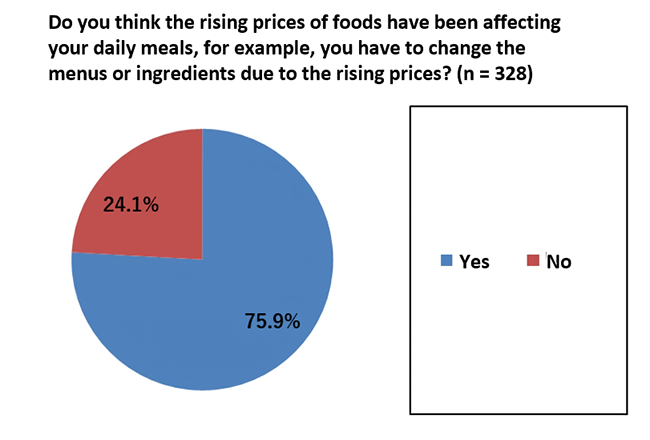
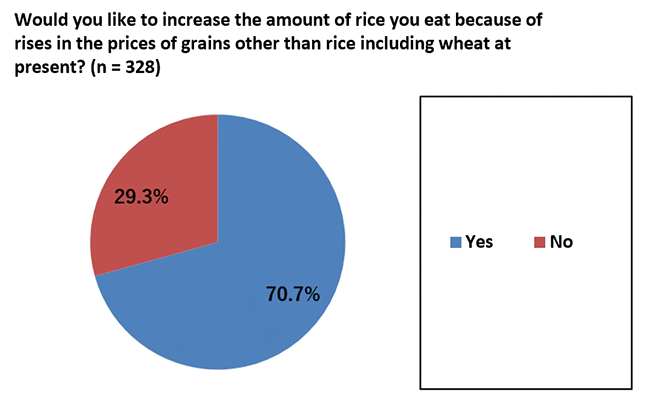

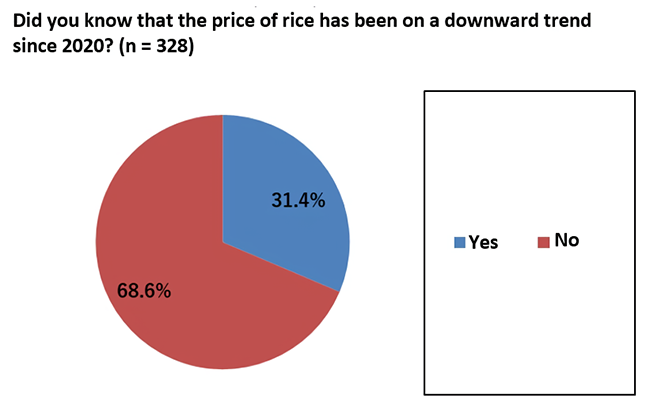


*2 Those surveyed: 328 men and women in their 20s to 50s who cook at home at least 4 times per week
Survey period: Wednesday, September 7, 2022 to Thursday, September 8, 2022; survey method: online survey (conducted by Tiger Corporation)
*If you cite any of the contents of this press release, please mention that the source is the survey conducted by Tiger Corporation.
How to cook delicious rice, what the person in charge of planning rice cookers actually does
The following shows the knack to cooking delicious rice as told by Ms. Tsujimoto, an employee of Tiger Corporation in charge of planning the rice cooker products.
 (1) Do you level off rice?
(1) Do you level off rice?
When you measure rice, do level off rice as this action taking only a few seconds makes the cooked rice delicious! Flattening the surface of powder or granulated materials by removing the raised portion with a chopstick or finger so that the top surface of the powder or granulated materials can be flush with the top edge of the container when measuring the powder or granulated materials is called leveling off. If the amount of rice to cook is not constant, you may fail to cook delicious rice or the rice at the bottom may get burned but you can prevent it by using the provided measuring cup and leveling off rice.
Although the capacity of a measuring cup commonly used for cooking is 200 mL, that of the cup coming with a rice cooker is 180 mL (= 1 go). Make sure to use the measuring cup that comes with your rice cooker to measure rice.
 (2) Start from learning the best way to rinse rice!
(2) Start from learning the best way to rinse rice!
It is important not to immerse rice in the water that you use first to rinse the rice for a long time but to pour off the water quickly. The estimated time you are allowed to immerse the rice in the water that you use first is about 10 seconds. After lightly stirring the rice, quickly pour off the water.
After draining the water, hold up two fingers and lightly stir the rice with the fingertips 20 to 30 times. After stirring and draining the water, pour water again and quickly drain the water and repeat this step a few times until the water remains clear. One of the key factors to cooking delicious rice is to remove the rice bran remaining on the polished rice and dust moderately and prevent the rice grains from deforming or losing their nutrients.
It is also important to use cold water to rinse rice!
 (3) There is a knack to loosening the cooked rice!
(3) There is a knack to loosening the cooked rice!
Loosen the rice immediately after it is cooked! The surfaces of the freshly cooked rice grains have extra moisture. If you leave it standing without loosening the rice, the moisture remaining on the surfaces of grains will cause the rice to get soggy and the rice grains to stick together in a cluster, which worsens the texture. Loosening the rice immediately after it is cooked lets the extra moisture evaporate and helps make the rice lustrous and improve the texture.
Loosen the cooked rice by crisscrossing a rice scoop on the surface of the cooked rice to cut the rice into quarters. Insert the rice scoop into each quarter along the inner side wall of the inner pot and scoop up the quarter of rice from its bottom and fold it to mix well. Crisscrossing is to mix the whole rice evenly without crushing the rice grains. The trick is to scoop it up gently.
Reference information | Presenting rice cooker products
Ceramic inner pot pressure IH rice cooker “炊きたて”土鍋ご泡火炊き JPL-S100 (released on July 21)
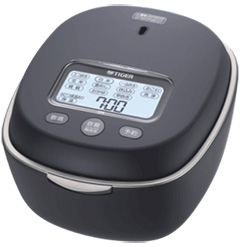


This is the 100 Year Anniversary Model produced with a collection of the sophisticated technologies developed for years by Tiger Corporation that will mark the 100th anniversary of its foundation in 2023. The 土鍋ご泡火炊き that brings out more of the sweetness of the rice at a maximum temperature of approx. 280°C* incorporates the new nonstop heating technique. This enabled the rice cooker to bring out the good flavors of rice as if the rice was cooked on a wood fired kamado (clay oven). This model is equipped with the painstaking finishing feature to bring out the sweetness and plumpness of rice while maintaining high heat and the rice bin humidity control feature modeled on a wooden rice bin, each of which has been very popular since it was incorporated into the previous model.
*Temperature of the outer bottom of the inner pot when cooking 5.5 go of rice in the White Rice setting in the Grainy mode with the heat set to High (based on our research)
Pressure IH rice cooker “炊きたて” JPV-A100/A180 (released on August 21)
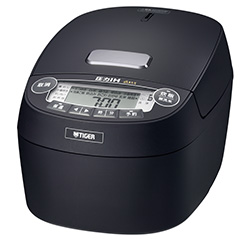

*JPV-A100 only

The rice cooker is equipped with the UMAMITSUBUDACHI rice cooking program for cooking tasty and firm plump rice, which was designed to reproduce the heating technique used in cooking rice in a clay pot with reference to the temperature control enabled in cooking rice in a clay pot, and the TSUBUDACHI keep-warm program for keeping rice warm and fluffy even hours after the rice is cooked. This model developed to meet the needs of the two-earner families that have to frequently keep cooked rice warm allows you to enjoy delicious rice even hours after the rice is cooked. The model also incorporates ingenious ways to save time and effort on a daily basis, such as the Small Amount Cooking and Frozen Rice settings.
Watch a movie outlining Tiger Corporation’s vision statement for the next 100 years — “Do Hot! Do Cool!”

Tiger Corporation will mark its 100th anniversary in 2023.
Since our founding, we have continued to focus on advanced thermal control through the use of vacuum insulation and thermal control technologies.
We will continue to make the best use of these technologies to spread joyous harmony throughout the world for the next 100 years.
“Do Hot! Do Cool!” Bring warmth for 100 years. Act cool for 100 years.
Japanese : https://youtu.be/MQe_G1aveuM
English : https://youtu.be/imqk_PCEJt4